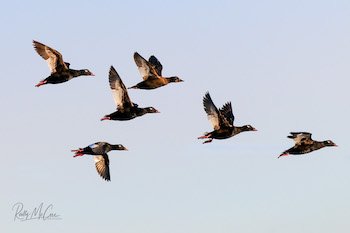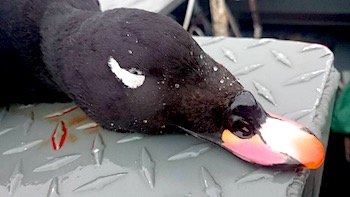White-winged Scoter

White-winged Scoter (Melanitta deglandi) is the largest scoter species, and are best characterized by living up to their white-winged namesake. Their white primary flight wing feathers starkly contrast with the rest of their jet black bodies. There’s a white eye-ring that is “swooshed up” behind the eye. The males have a black knob at the base of their tri-colored, sloping bill that displays pink, white, yellow, and orange. White-winged Scoter females lack the knob and have brown plumage overall. They do display white on their wings and two patches on the side of the face, one before and one after the eye.
Available Hunts
-
Alaska King Eider Hunting
Alaska King Eider hunt tops the life-list of most avid duck hunters and bird collectors.
...read moreAlaska King Eider hunting is for the true adventurer-collector that wants to hunt the most beautiful North American duck. King Eider, Harlequin Duck, Long-tailed Duck, White-wing Scoter.
- 100% success rate on trophy king eiders
- Most practical place on earth to hunt king eider trophies
- Dedicated staff, 40 years combined guide experience
- GetDucks.com pre-trip and travel services best prepares you for success
- Top-of-the line equipment
- As featured in Shooting Sportsman, Wildfowl, more December 2012
Rate: $7,000 -
New England Sea Duck Hunting
World renown for its eider hunting, New England waterfowling offers an incredible change of scenery and is an excellent place to check off lots of North America waterfowl species. Codfather Charters specializes in making your hunt priorities a reality.
...read more- Decade-plus experience for trophy eiders, other sea ducks, divers, dabblers, mergansers, geese
- Best place in US to harvest prime American black ducks
- Customized hunt plans reflect hunter priorities, not a “one size fits all” type 1/2-day hunt
- Includes hotel accommodations, full-day hunting, continental breakfasts, made-to-order lunches
- Recognized as foremost among US waterfowl collectors and taxidermists
- Nearby non-hunting spouse activities abound
Rate: $2,500 for 3-day inclusive package

White-winged Scoters will choose freshwater breeding areas in the western boreal forests from Alaska through western Canada. Females will return to the site where they hatched during the breeding season, a behavior called “natal philopatry.” Their nesting habits align with some gull species, which predate on scoter eggs. For extra protection, White-winged Scoters will nest in areas of dense vegetation and are a long (300 feet) distance from water, which does not attract gulls. Preferred vegetation has thorns, such as rose bushes. Their diet consists of insects, crustaceans, and aquatic plants.
After the breeding season, White-winged Scoter form small groups to reach their wintering grounds, where they either remain in small groups or can be found in massive flocks with other scoter species. During the wintering season, White-winged scoters either congregate on the Pacific or Atlantic Coasts. The Pacific Coast population ranges from the Aleutian Islands and partially into Mexico. The Atlantic Coast population goes from Maine to Georgia.
There are sparse White-winged Scoter populations on the Gulf of Mexico and around the Great Lakes. Despite using freshwater for foraging during the breeding season, saltwater areas are the desired area for wintering White-winged scoters, relying on animal matter to fulfill their dietary needs. White-winged Scoters will eat fish, oysters, clams, and snails







